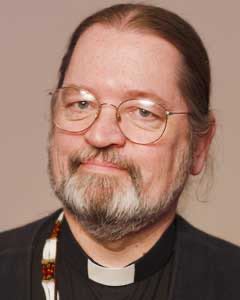A Eucharist that embraces a pandemic
The pandemic has delivered uncomfortable restraints on the central act of our faith: the ceremony Jesus gave so that we might live in faith, hope and love until he comes again. In the midst of our many conversations about this, I was startled to read Alexander Schmemann’s prophetic words from 1964:
The liturgy is still the centre of our church life, unquestioned, unchallenged, unopposed. But it is in fact a centre without periphery, a heart with no control on blood circulation, a fire with nothing to purify and to consume, because that life which had to be embraced by it, has been satisfied with itself and has chosen other lights to guide and shape it.

Fr. Schmemann, who died in 1983, taught many of us to place the Eucharist at the centre of the Christian life. What he says above pushes us beyond the true but uncompleted idea that the Eucharist is our centre. The Eucharist is not just the centre; it is to inform every aspect of existence, to energize every moment of our visit within God’s Creation. It is not just the centre of life; it is to touch and fill all of life. In every way, it speaks as much to when it is not present, as it speaks to when it is present.
In my type of ministry, there are frequent encounters with Christians who go for long periods of time without Eucharist. This is especially true in Indigenous communities. This is not because of their choice, but because of the remoteness of the ministry of the church. In all cases, it is observed that the Eucharist is deeply cherished, but people must embrace its central message and values in other ways. It is present through moral and spiritual practice, rather than as a consistent or frequent ceremony.
Here I am not arguing for less communion. I long to see it more. What is important here is the way we let it abide in those times and places when we are apart from the liturgy. The Eucharist desires to become a living and converting presence outside of our Sunday worship. It would appear to be designed for that presence.
Considering this, I would gently suggest that the idea of a “Eucharistic fast” is not the best way to treat this unfamiliar time. Perhaps, we are called to new ways to live the Eucharist, to live in the Eucharist, to live out the Eucharist. There seem to be noble attempts to make this happen, as in Pope Francis’s portrayal of the “Cross to Resurrection” message in his lonely Holy Week and Eastertide pilgrimages around Rome. We do need to find new safe protocols to have prayer and Eucharist present, especially at times of sickness and death. But at other times, we could find ways to live Eucharist in courage and compassion for the poor and vulnerable in this dangerous time.
May we please work together towards more ways to safely practice our central ceremony. In this way, may we work together for a broader experience of Eucharist. Jesus promised he would come with a New Heaven and a New Earth. The Eucharist is a first taste of that divine reality. It is a taste that radiates out in salvation, forgiveness, justice, reconciliation and hope. It is promised to be especially present at times of great distress for creation and humanity—times like now.
Cover photo: Remi Wall/Unsplash
Author
-

Mark MacDonald
Mark MacDonald was national Indigenous Anglican bishop of the Anglican Church of Canada from 2007 to 2019, and national Indigenous Anglican archbishop from 2019 to 2022.





